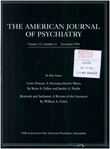Dissociation in women with chronic pelvic pain
Abstract
OBJECTIVE: The authors' goal was to determine if women with chronic pelvic pain are significantly more likely to use dissociation as a coping mechanism than women without pain. METHOD: The subjects were recruited from women who attended a university women's clinic during a 1-month period. Twenty-two women who reported that they had at any time in their lives experienced pelvic pain nearly every day for a period of at least 6 months were included in the study, along with 21 randomly selected women without a history of chronic pelvic pain. The 43 women were given structured sexual assault interviews and completed psychological self-report measures. RESULTS: The women with chronic pain were significantly more likely to use dissociation as a coping mechanism, to show current psychological distress, to see themselves as medically disabled, to experience vocational and social decrements in function, and to amplify physical symptoms. They were also significantly more likely to have experienced severe childhood sexual abuse. In the total study group, women with a childhood history of sexual abuse had significantly higher scores on measures of psychological distress, somatization, and dissociation and viewed their physical health and functioning as more impaired. CONCLUSIONS: The authors discuss a model for the development of somatization, dissociation, and pain symptoms in victims of early sexual abuse.
Access content
To read the fulltext, please use one of the options below to sign in or purchase access.- Personal login
- Institutional Login
- Sign in via OpenAthens
- Register for access
-
Please login/register if you wish to pair your device and check access availability.
Not a subscriber?
PsychiatryOnline subscription options offer access to the DSM-5 library, books, journals, CME, and patient resources. This all-in-one virtual library provides psychiatrists and mental health professionals with key resources for diagnosis, treatment, research, and professional development.
Need more help? PsychiatryOnline Customer Service may be reached by emailing [email protected] or by calling 800-368-5777 (in the U.S.) or 703-907-7322 (outside the U.S.).



